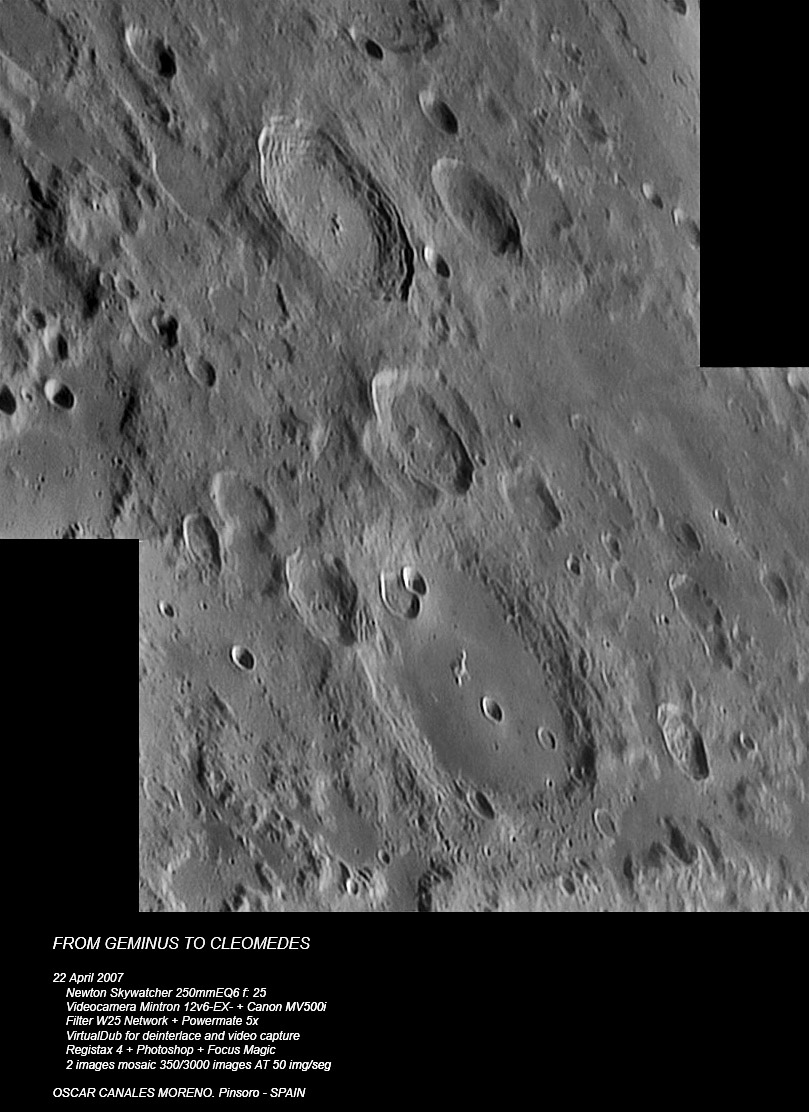|
|
| (5 intermediate revisions by the same user not shown) |
| Line 1: |
Line 1: |
| | __NOTOC__ | | __NOTOC__ |
| | =Naming Names= | | =Naming Names= |
| | + | <!-- Start of content --> |
| | <div class="post" id="post-1481"> | | <div class="post" id="post-1481"> |
| | | | |
| Line 7: |
Line 8: |
| | <p>image by[mailto:ocanales@able.es Oscar Canales Moreno], Pinsoro, Spain</p> | | <p>image by[mailto:ocanales@able.es Oscar Canales Moreno], Pinsoro, Spain</p> |
| | <p>Can you name more than one crater in this view?<br /> | | <p>Can you name more than one crater in this view?<br /> |
| − | For many observers this piece of real estate north of [http://the-moon.wikispaces.com/Mare Crisium Mare Crisium] is vaguely familiar, but probably few if any craters other than [http://the-moon.wikispaces.com/Cleomedes Cleomedes] can be identified without a map. [http://the-moon.wikispaces.com/Burckhardt Burckhardt] is the one with the big ears, and north of that is the young crater [http://the-moon.wikispaces.com/Geminus Geminus]. There are four other named craters visible that are even less noticed. Just east (right) of Geminus is [http://the-moon.wikispaces.com/Bernoulli Bernoulli], a smaller, more subdued version of Geminus. And breaking the northwest rim of Cleomedes is [http://the-moon.wikispaces.com/Tralles Tralles], another yet smaller and milder version of Geminus. Immediately northwest is a pair of slightly overlapping craters, the northern having the name of [http://the-moon.wikispaces.com/Debes Debes]. Such overlapping craters often form by simultaneous impact, and many are secondary craters. But Debes and its overlapper are each about 30 km in diameter, so big that they must be basin secondaries (from Crisium?), if they are secondaries. The sharp-rimmed but relatively shallow crater [http://the-moon.wikispaces.com/Delmotte Delmotte] is the last named crater visible, to the east of Cleomedes. Debes and Delmotte were early 20th century selenographers who were nearly invisible to the English speaking world. There is one other named feature here - it is the nearly horizontal mountain at the bottom of the image. This is the rim of the Crisium impact basin, unnamed until I called it the [http://www.lpod.org/?m=20060203 Wasatch Mountains]. </p> | + | For many observers this piece of real estate north of [https://the-moon.us/wiki/Mare Crisium Mare Crisium] is vaguely familiar, but probably few if any craters other than [https://the-moon.us/wiki/Cleomedes Cleomedes] can be identified without a map. [https://the-moon.us/wiki/Burckhardt Burckhardt] is the one with the big ears, and north of that is the young crater [https://the-moon.us/wiki/Geminus Geminus]. There are four other named craters visible that are even less noticed. Just east (right) of Geminus is [https://the-moon.us/wiki/Bernoulli Bernoulli], a smaller, more subdued version of Geminus. And breaking the northwest rim of Cleomedes is [https://the-moon.us/wiki/Tralles Tralles], another yet smaller and milder version of Geminus. Immediately northwest is a pair of slightly overlapping craters, the northern having the name of [https://the-moon.us/wiki/Debes Debes]. Such overlapping craters often form by simultaneous impact, and many are secondary craters. But Debes and its overlapper are each about 30 km in diameter, so big that they must be basin secondaries (from Crisium?), if they are secondaries. The sharp-rimmed but relatively shallow crater [https://the-moon.us/wiki/Delmotte Delmotte] is the last named crater visible, to the east of Cleomedes. Debes and Delmotte were early 20th century selenographers who were nearly invisible to the English speaking world. There is one other named feature here - it is the nearly horizontal mountain at the bottom of the image. This is the rim of the Crisium impact basin, unnamed until I called it the [[February_3,_2006|Wasatch Mountains]]. </p> |
| | <p>[mailto:tychocrater@yahoo.com Chuck Wood]</p> | | <p>[mailto:tychocrater@yahoo.com Chuck Wood]</p> |
| | <p><b>Technical Details:</b><br /> | | <p><b>Technical Details:</b><br /> |
| Line 14: |
Line 15: |
| | Rükl plates 16 & 26<br /> | | Rükl plates 16 & 26<br /> |
| | Lunar Orbiter IV [http://www.lpi.usra.edu/resources/lunar_orbiter/bin/info.shtml?131 view] of nearly the same scene.</p> | | Lunar Orbiter IV [http://www.lpi.usra.edu/resources/lunar_orbiter/bin/info.shtml?131 view] of nearly the same scene.</p> |
| − | <p align="center"> | + | <p><b>Yesterday's LPOD:</b> [[October 28, 2007|Not a Lucky Shot]] </p> |
| − | <i>Now you can support LPOD when you buy ANY book from Amazon thru [[LPOD]]</i></p> | + | <p><b>Tomorrow's LPOD:</b> [[October 30, 2007|Rims on the Limb]] </p> |
| | + | <!-- Removed reference to store page 2 --> |
| | </div> | | </div> |
| − | ---- | + | <!-- End of content --> |
| − | ===COMMENTS?===
| + | {{wiki/ArticleFooter}} |
| − | Click on this icon [[image:PostIcon.jpg]] at the upper right to post a comment.
| |




